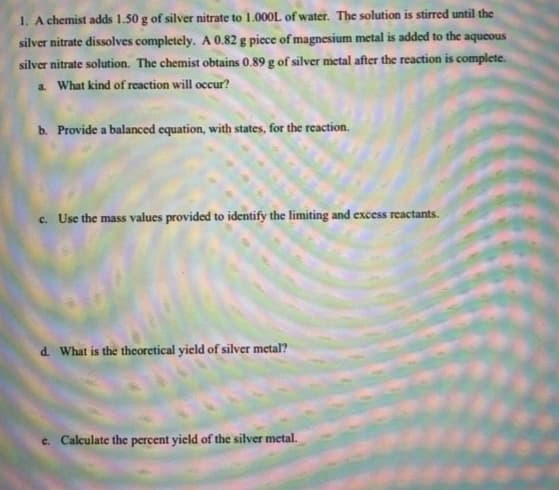1. A chemist adds 1.50 g of silver nitrate to 1.000L of waler. silver nitrate dissolves completely. A 0.82 g piece of magnesium metal is added to the aqueous silver nitrate solution. The chemist obtains 0.89 g of silver metal after the reaction is complete. a What kind of reaction will occur? b. Provide a balanced equation, with states, for the reaction. c. Use the mass values provided to identify the limiting and excess reactants.
1. A chemist adds 1.50 g of silver nitrate to 1.000L of waler. silver nitrate dissolves completely. A 0.82 g piece of magnesium metal is added to the aqueous silver nitrate solution. The chemist obtains 0.89 g of silver metal after the reaction is complete. a What kind of reaction will occur? b. Provide a balanced equation, with states, for the reaction. c. Use the mass values provided to identify the limiting and excess reactants.
Introductory Chemistry: A Foundation
9th Edition
ISBN:9781337399425
Author:Steven S. Zumdahl, Donald J. DeCoste
Publisher:Steven S. Zumdahl, Donald J. DeCoste
Chapter9: Chemical Quantities
Section: Chapter Questions
Problem 55QAP: A common method for determining how much chloride ion is present in a sample is to precipitate the...
Related questions
Question
100%
answer all parts .or else I will downvote

Transcribed Image Text:1. A chemist adds 1.50 g of silver nitrate to 1.000L of water. The solution is stirred until the
silver nitrate dissolves completely. A 0.82 g piece of magnesium metal is added to the aqueous
silver nitrate solution. The chemist obtains 0.89 g of silver metal after the reaction is complete.
a What kind of reaction will occur?
b. Provide a balanced equation, with states, for the reaction.
c. Use the mass values provided to identify the limiting and excess reactants.
d. What is the theoretical yield of silver metal?
c. Calculate the percent yield of the silver metal.
Expert Solution
This question has been solved!
Explore an expertly crafted, step-by-step solution for a thorough understanding of key concepts.
This is a popular solution!
Trending now
This is a popular solution!
Step by step
Solved in 6 steps

Knowledge Booster
Learn more about
Need a deep-dive on the concept behind this application? Look no further. Learn more about this topic, chemistry and related others by exploring similar questions and additional content below.Recommended textbooks for you

Introductory Chemistry: A Foundation
Chemistry
ISBN:
9781337399425
Author:
Steven S. Zumdahl, Donald J. DeCoste
Publisher:
Cengage Learning

Chemistry: Matter and Change
Chemistry
ISBN:
9780078746376
Author:
Dinah Zike, Laurel Dingrando, Nicholas Hainen, Cheryl Wistrom
Publisher:
Glencoe/McGraw-Hill School Pub Co

Chemistry for Engineering Students
Chemistry
ISBN:
9781337398909
Author:
Lawrence S. Brown, Tom Holme
Publisher:
Cengage Learning

Introductory Chemistry: A Foundation
Chemistry
ISBN:
9781337399425
Author:
Steven S. Zumdahl, Donald J. DeCoste
Publisher:
Cengage Learning

Chemistry: Matter and Change
Chemistry
ISBN:
9780078746376
Author:
Dinah Zike, Laurel Dingrando, Nicholas Hainen, Cheryl Wistrom
Publisher:
Glencoe/McGraw-Hill School Pub Co

Chemistry for Engineering Students
Chemistry
ISBN:
9781337398909
Author:
Lawrence S. Brown, Tom Holme
Publisher:
Cengage Learning

Chemistry: The Molecular Science
Chemistry
ISBN:
9781285199047
Author:
John W. Moore, Conrad L. Stanitski
Publisher:
Cengage Learning

Chemistry: An Atoms First Approach
Chemistry
ISBN:
9781305079243
Author:
Steven S. Zumdahl, Susan A. Zumdahl
Publisher:
Cengage Learning

Chemistry
Chemistry
ISBN:
9781305957404
Author:
Steven S. Zumdahl, Susan A. Zumdahl, Donald J. DeCoste
Publisher:
Cengage Learning